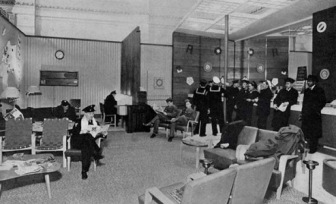
Diana Zuckerman is the founder and president of the National Center for Health Research. She develops prevention strategies and treatments for programs such as the Cancer Prevention and Treatment Fund.
Asbestos is a toxic mineral made of tiny, heat-resistant fibers. When disturbed, it releases dangerous microscopic fibers into the air. Breathing in these fibers can lead to serious diseases, such as mesothelioma, lung cancer and asbestosis.

Exclusive Content
Tim Povtak: What is asbestos exposure and how does it happen?

Exclusive Content
Tim Povtak: What is asbestos exposure and how does it happen?
Exposure to asbestos happens when the mineral’s fibers become airborne. Breathing in asbestos fibers can lead to mesothelioma, lung cancer and asbestosis.
Most asbestos exposure happens at work, especially in construction, shipbuilding and in military occupations. But instances of secondhand exposure are common. Living near asbestos mines or factories can also lead to exposure.
The material was widely used in many products and industries. Tiny fibers from car parts, building materials and industrial items can enter the air. People may not know they inhaled asbestos because the fibers are so small.
There is no safe level of asbestos exposure. Even a single heavy exposure is dangerous. Not everyone gets sick, but repeated exposure increases the risk.
Key Facts About Asbestos Exposure
While all types of asbestos cause cancer, some types are less lethal than others. The term “asbestos” actually refers to six distinct minerals: chrysotile, amosite, crocidolite, tremolite, anthophyllite and actinolite.
While all six types of asbestos can cause serious illness, the many commercial uses of chrysotile make it the most commonly encountered form. Types like crocidolite and amosite are generally regarded as more potent in causing diseases when fibers become airborne.
Industrial workers faced the most asbestos exposure. Workers in construction and manufacturing also had a high risk. As a result of their loved ones’ jobs, their family members were also at risk of secondhand exposure. Mesothelioma becomes a risk with continued exposure.
Workers at Risk for Asbestos Exposure
Using cosmetics with talc that contains asbestos also puts people at risk. People can breathe in asbestos from living near contaminated sites. Disasters can also disturb asbestos in buildings.
“I first came in contact with asbestos through the brakes of cars,” mesothelioma survivor Epifanio Figueroa told us. “I also used to be a mechanic for our household. So, I would disassemble cars and come into contact with asbestos.”
Occupational asbestos exposure is the No.1 cause of mesothelioma. Before the bans on asbestos, many industries used it in products and buildings. This put millions of workers in danger. U.S. workers in mining, heavy industry and all construction trades were often exposed to asbestos fibers while on the job.
Auto mechanics and other workers still face risks today. Companies must lower these risks to ensure worker safety. Asbestos removal workers must follow the right abatement steps. If they don’t, there’s a high risk of exposure to airborne asbestos fibers.

Asbestos companies made many products, from building materials to appliances. They added it to insulation, drywall, ceiling and floor tiles. Offices, schools and public buildings built before the 1980s might still have asbestos. Older military housing and private homes may contain asbestos products.
Asbestos can be found in automotive parts, planes, trains and other machinery. It was used in brakes, clutches and other friction products.
Asbestos-contaminated talc also presents an exposure risk. Baby powder, makeup, and many kids’ products have shown asbestos in recent tests.

Military personnel faced asbestos exposure during the 20th century. All branches of the U.S. armed forces used it for fireproofing to keep them safe. Old asbestos products are still a risk today. Veterans are also at risk of exposure abroad.
Service members on Navy vessels or military vehicles and aircraft from the 1930s to the 1970s were at high risk. Naval shipyard workers were another high-risk group. They were exposed to toxic materials while working on Navy vessels. Even short-term exposure could lead to illness later in life.
Buildings on military bases often used asbestos. Some still pose risks today. Service members with asbestos-related diseases can get VA help for benefits and health care.
“If the majority of a veteran’s exposure was on active-duty matters, then the VA can approve mesothelioma for benefits,” says Aaron Munz, former U.S. Army Captain and director of the Veterans Department at The Mesothelioma Center.
Environmental asbestos exposure happens from industrial operations. Living near an asbestos mine or manufacturing plant can lead to this type of exposure.
Asbestos mine tailings used in roads and driveways is another example. Driving on contaminated materials kicks up asbestos dust. Repeated environmental exposure over time can lead to illness later in life.
Work that releases asbestos fibers threatens nearby communities. Even short exposure has caused disease in those who live near asbestos operations.
This exposure happens when manmade or natural disasters strike. Tornadoes, earthquakes, hurricanes, and fires can harm buildings that have asbestos. First responders and cleanup crews are most at risk.
A manmade example of disaster exposure is the 2001 World Trade Center terrorist attack. The twin towers’ collapse released tons of asbestos into New York City’s air. Researchers now track those exposed. A study showed 70% of emergency responders had respiratory issues in the years after the attack.
Secondary exposure can also lead to mesothelioma. Some call it indirect or secondhand exposure. It happens when asbestos workers take fibers home on their clothing, hair or skin. Family members and others in the home can breathe in these fibers. This increases their risk of disease.
Before regulations in the 1980s, there were more cases of secondary exposure. New cases still arise. This is especially true for women and children exposed to asbestos decades ago, as they are now showing symptoms. The highest risk in homes was for women who laundered contaminated clothes.
Mesothelioma survivor Carla Fasolo is one of those people who developed the disease from secondhand exposure. “I’d go down to the boiler room where my dad worked. It was very dusty. There were chunks of gray, fibrous stuff,” Carla told us. “I didn’t know it was asbestos. I’d pick it up and play with it. I helped my mother with the laundry, shaking it, getting the dust off his clothes.

We’ll get you the best doctor for your diagnosis and schedule appointments with them quickly.
Get Help NowWhen tiny asbestos fibers are inhaled, they slip past the lungs’ usual defense mechanisms and become lodged. Over many years, these fibers irritate lung tissue and cause repeated damage, which can eventually lead to cancer.
As researchers continue to study this, it is clear that the physical and chemical properties of asbestos fibers, such as length, durability and chemical composition, play crucial roles in how the body responds and whether diseases develop.
The most common cancers caused by asbestos exposure are mesothelioma and lung cancer. Asbestos exposure causes about 4% of lung cancer cases. Symptoms appear 20 to 60 years after exposure.
Asbestos-Related Cancers
Asbestos fibers can travel to various organs and lead to scarring. This leads to DNA damage, which can result in cancer.
Some lung diseases from asbestos, such as asbestosis and pleural plaques, are not cancerous, but they can still harm your health and daily life. Those diagnosed have had enough asbestos exposure to be at risk for cancer later in life.
Asbestos-Related Lung Conditions
Make an appointment with your doctor if you notice signs of asbestos exposure. Difficulty breathing, cough and chest pain are common symptoms of these conditions.
“Any time you move, you cough, you laugh, you bend over, or you get in a car with an active case of pleurisy you feel pain. Anything that rubs up against the pleural sack is very painful.”
Symptoms of each type of mesothelioma vary by where tumors form. Sometimes, these symptoms mimic less serious conditions.
| Asbestos-Related Disease | Asbestos-Related Disease Affected Area | Typical Latency Period (Years) | Common Initial Symptoms |
|---|---|---|---|
| Mesothelioma (Pleural/Peritoneal) | Lining of lung/abdomen (pleura/peritoneum) | 20 to 60 Years | Shortness of breath, chest pain, unexplained weight loss, fatigue |
| Asbestosis | Lung tissue | 10 to 30 Years | Persistent, dry cough, shortness of breath, crackling sound when breathing |
| Asbestos-Related Lung Cancer | Lung tissue | 15 to 35 Years | Chronic cough, chest pain, coughing up blood, chronic respiratory infections |
| Pleural Plaques | Lining of the lungs | 20 to 30 Years | Often asymptomatic, but chest pain or trouble breathing may occur |
As with all asbestos-related diseases, their latency periods and locations make them harder to spot. Make an appointment with your doctor if you notice these signs of asbestos exposure.
Safety measures are needed at work to prevent asbestos exposure. Employers need to ensure workplaces are safe from asbestos exposure. If an employer is careless, workers can report it. They must tell the Occupational Safety and Health Administration.
People can also take steps to protect themselves and their families. The U.S. Environmental Protection Agency offers guidelines to prevent exposure.
“Asbestos-related disease is 100% preventable,” Dr. Ken Takahashi told us. He directs the Asbestos Disease Research Institute in Australia. “That fact motivates me. It should motivate all of us. If we stopped using asbestos, by definition, we could stop asbestos disease.”
In the U.S., employers and building owners have legal duties when materials containing asbestos are present. These OSHA and EPA rules help protect workers and occupants.
By knowing these legal responsibilities, you can ask the right questions of your employer or property manager, such as “Has an asbestos survey been done?” and ensure you’re working or living in a safe environment.
There is no safe amount of asbestos exposure. Even a single exposure can be harmful at high concentrations. The small fibers that make up asbestos can be breathed in without noticing. These fibers can get stuck in your lungs and may cause health problems later. The chance of developing an illness from just one exposure is low. If you think you were exposed, talk to a doctor so they can monitor your health.
Anyone exposed to asbestos who has symptoms of mesothelioma should see a doctor. Mesothelioma doctors can also check for misdiagnosis.
If you have an asbestos-related disease, you might be eligible for compensation. You may qualify to claim mesothelioma compensation from:
If you got sick from asbestos exposure, you should talk to a specialized asbestos lawyer. They can advise you and help you get the compensation you deserve.
The first signs of asbestos exposure include pain, loss of appetite, fever and excessive sweating. Fatigue, weakness and unexplained weight loss can also be common.
Stay up-to-date on treatment, research, clinical trials, doctors and survivors
The information on this website is proprietary and protected. It is not a substitute for professional medical advice, diagnosis or treatment. Any unauthorized or illegal use, copying or dissemination will be prosecuted. Please read our privacy policy and terms of service for more information about our website.
This website and its content may be deemed attorney advertising. Prior results do not predict a similar outcome.
The Mesothelioma Center’s claim as the most trusted resource is based on our more than 150 5-star Google and BBB reviews. Our organization also helps more than half of all mesothelioma patients annually diagnosed.
Your web browser is no longer supported by Microsoft. Update your browser for more security, speed and compatibility.
If you are looking for mesothelioma support, please contact our Patient Advocates at (855) 404-4592
The Mesothelioma Center at Asbestos.com has provided patients and their loved ones the most updated and reliable information on mesothelioma and asbestos exposure since 2006.
Our team of Patient Advocates includes a medical doctor, a registered nurse, health services administrators, veterans, VA-accredited Claims Agents, an oncology patient navigator and hospice care expert. Their combined expertise means we help any mesothelioma patient or loved one through every step of their cancer journey.
More than 30 contributors, including mesothelioma doctors, survivors, health care professionals and other experts, have peer-reviewed our website and written unique research-driven articles to ensure you get the highest-quality medical and health information.
My family has only the highest compliment for the assistance and support that we received from The Mesothelioma Center. This is a staff of compassionate and knowledgeable individuals who respect what your family is experiencing and who go the extra mile to make an unfortunate diagnosis less stressful. Information and assistance were provided by The Mesothelioma Center at no cost to our family.LashawnMesothelioma patient’s daughter


Whitmer, M. (2025, November 11). Asbestos Exposure. Asbestos.com. Retrieved December 14, 2025, from https://www.asbestos.com/exposure/
Whitmer, Michelle. "Asbestos Exposure." Asbestos.com, 11 Nov 2025, https://www.asbestos.com/exposure/.
Whitmer, Michelle. "Asbestos Exposure." Asbestos.com. Last modified November 11, 2025. https://www.asbestos.com/exposure/.
We Thoroughly vet individuals who are experts in their field to contribute to articles on Asbestos.com. We believe in the integrity and quality of our educational materials, and only publish information that is relevant, factual, and backed by experts.

Diana Zuckerman is the founder and president of the National Center for Health Research. She develops prevention strategies and treatments for programs such as the Cancer Prevention and Treatment Fund.
Our fact-checking process begins with a thorough review of all sources to ensure they are high quality. Then we cross-check the facts with original medical or scientific reports published by those sources, or we validate the facts with reputable news organizations, medical and scientific experts and other health experts. Each page includes all sources for full transparency.
Please read our editorial guidelines to learn more about our content creation and review process.
